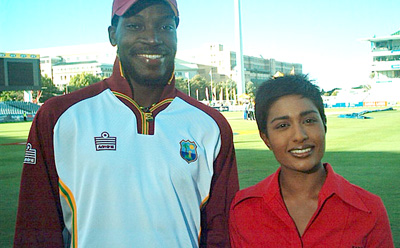By Kass Naidoo
My return to the Test cricket commentary box this summer for England’s tour of South Africa on SABC Sport has been nothing short of amazing, speaking personally.

A picture of West Indies batsman Chris Gayle with the SABC’s Kass Naidoo, at Newlands in Cape Town during the 2003/04 tour of South Africa. Photo: Supplied
As a woman in the men’s game, being in the commentary box has always been a privilege that I’ve approached with the utmost respect.
The reality is that women journalists’ entry to professional sports broadcasting is still a fairly novel issue, and accommodating us presents something of a challenge.
I made my television debut for SABC Sport at the 2003 ICC World Cup in South Africa. It was the realization of a dream that began when I was just 14 years old, when I heard the incredible Donna Symmonds commentate on a Tri-Series in South Africa.
It was something I had worked for, sweated over, agonized about, and eventually achieved.
That summer, the West Indies toured SA for the Sir Vivian Richards Trophy, the Proteas winning the four-Test series 3-0, and the 5-match ODI series 3-1.
I remember Chris Gayle, the epitome of Caribbean suave. I also remember the highest courtesy of respect from him and the entire West Indian team. I am glad that cricket is so often the sport of choice for honorable men.
But I have never suffered the indignity of being reduced to the subject of a pick-up line in a broadcast. If I had, I’d have been proud to carry it off with the calm demonstrated by Mel McLaughlin after being on the receiving end of this from Gayle during a recent Big Bash league match:
“I wanted to come and have an interview with you as well,” Gayle said to McLaughlin, when asked about how aggressively he had batted. “That’s the reason why I’m here, just to see your eyes for the first time. It’s nice so. Hopefully we can win this game and have a drink after. Don’t blush, baby.”
He probably considered it a risqué ‘compliment’ in the moment – and the snickering in the broadcast confirms that he’s not alone – but the danger of entrenching an entitlement to public objectification of women looms large.
Despite McLaughlin’s unflappable demeanor, it became a worldwide talking point. Outrage was on another level, and hats off to BBL stakeholders for acting promptly in addressing the transgression, and fining the player.
But unfortunately the storm continues, and the focus is no longer on McLaughlin or the rights of women in cricket, but rather on demonizing Gayle – with one commentator calling for a world ban.
I consider Gayle the Usain Bolt of Cricket. But what he did was stupid, and I’m sure that he acknowledges that it was uncalled for. He is unlikely to repeat it.
Stakeholders market this format of the game as family entertainment, and sponsors commit huge assets to align their brands with cricket. There simply is no place for such behavior in cricket, and on live TV.
When Alison Mitchell of BBC Test Match Special approached Natalie Germanos and I about the incident, my first reactions was that we have to toughen up, that’s all. The world is what it is.
On reflection, I maintain that there is no need to get hysterical about this incident, and that we should avoid taking extreme action.
What we need is calm heads, consistent support and a commitment to a safe environment for all professionals, including a new appreciation for the provision of safety of women journalists.
In my early days of cricket broadcasting, I often found it difficult to get to- and from the field after a post match presentation. I would be mobbed afterwards by fans, and there were inappropriate comments at times. My sound operator regularly doubled up as my bodyguard on those occasions when an intervention was called for.
Governing bodies have the opportunity to take this lead, by proposing clauses protecting journalists for inclusion in MOU’s, holding all stakeholders accountable. There are more opportunities than ever for women in cricket, and now is not the time to take our eye off the ball.
The long-standing success of the BBC’s Alison Mitchell, my accomplished SABC colleague, Natalie Germanos, and the recent success of women IPL commentators Isa Guha, Anjum Chopra, Lisa Sthalekar and Mel Jones – shows that world cricket is ready for more women to take the lead in cricket’s television appeal.
But legal documents alone will not make this a safe place for journalists. My advice to women in cricket broadcasting is to be wise, and get stronger! Things are going to get tougher before they get better. Focus on your own game, work hard to be the best, and continue paving the way for future generations to come!
The above article is reproduced with permission from http://kassnaidoo.co.za